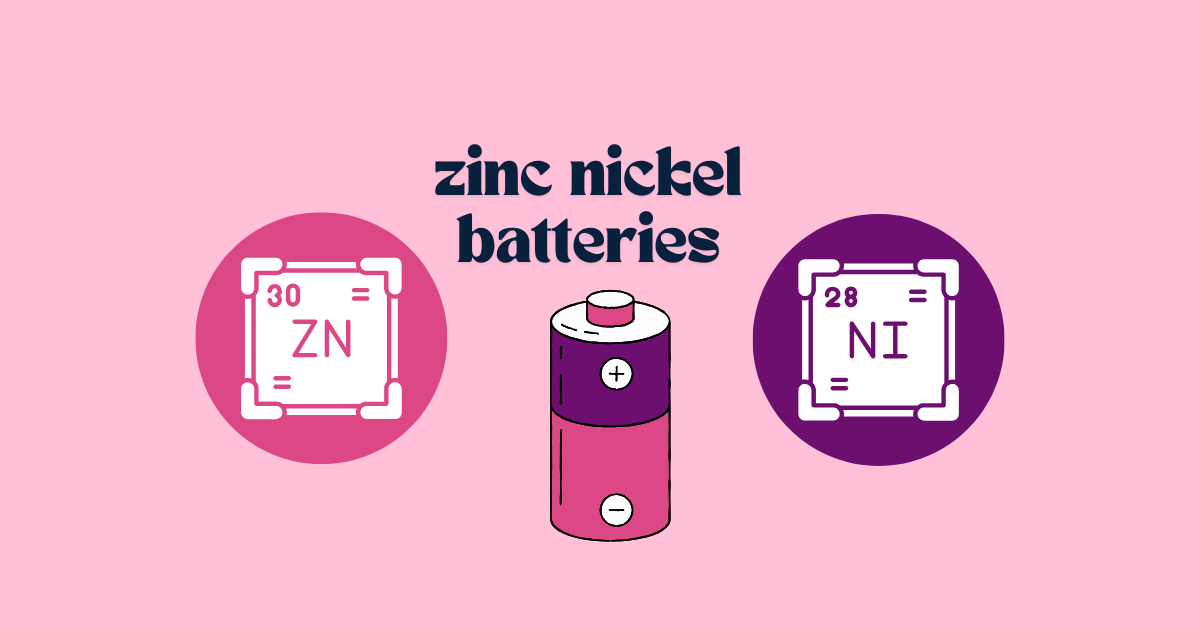Nickel zinc batteries (NZBs) are a low cost, high-capacity alternative to lithium-ion batteries due to the abundance of the active materials and the multivalent nature of the zinc electrode. The use of aqueous electrolytes gives NZBs innate safety advantages including a reduced risk of thermal runaway compared to Li-ion batteries, which have electrolytes based on flammable organics.1,2
Not without some problems
Unfortunately, irreversible byproducts, corrosion, capacity reduction, shape changes, and dendrite growth all inhibit the cycle life of NZBs. Researchers have attempted to combat these problems with structural changes and additives in order to improve the cycle life and energy density of secondary nickel zinc batteries.3
The electrolyte commonly used in aqueous NZBs is potassium hydroxide (KOH), and this paired with the low working potential of zinc and high working potential of nickel gives NZBs a higher operating voltage (1.8V) than most aqueous battery chemistries.4
For a typical NZB battery system the overall redox reaction is:5
Zn + 2NiOOH + H2O ⇌ ZnO + 2 Ni(OH)2 (Uθ = 1.8 V)
Where the nickel cathode reaction is:5
2NiOOH + 2H2O + 2e− ⇌ 2Ni(OH)2 + 2 OH− (Uθ = 0.52 V)
And the overall zinc anode reaction is:5
Zn + 2OH− ⇌ ZnO + H2O + 2e− (Uθ = -1.28 V)
This reaction occurs in two steps; first zinc is converted to zincate by the dissolution reaction:6
Zn +4OH− ⇌ Zn(OH)42- + 2e- (Uθ = -1.28 V)
The solubility of the zincate in the alkaline electrolyte depends on the pH of the solution and any additives present.7 When the solubility limit is reached zincate will precipitate out as zinc oxide:6
Zn(OH)42- ⇌ ZnO(s) + 2OH− + H2O
The creation of a zinc oxide layer on the surface of the anode can cause zinc passivation and a reduction in capacity, electrolyte volume, porosity, and conductivity. Zinc dissolution over time can cause shape changes and dendrite growth, a reduction in capacity, and ultimately can result in battery failure.3
A competing zinc corrosion reaction that can occur is known as the hydrogen evolution reaction (HER) and is as follows:
Zn + 2H2O → Zn(OH)2 + H2
This reaction reduces the coulombic efficiency of the battery as it irreversibly depletes the zinc and the electrolyte in the battery. The production of flammable hydrogen gas also reduces the safety of the battery and can have a negative impact on the sealing structure of the cell.3
Additives and structural changes to combat these problems
Electrode additives are used to suppress the HER, to prevent zinc shape change, and to improve the cycle life of the zinc anode. Typical additives in a zinc anode are Bi2O3,7,8 Ca(OH)2,9–11 In2O3,12 and In(OH)313. Due to the infeasibility of mercury or lead oxide additives for environmental and safety concerns they have not been included within the scope of this paper.10
Calcium hydroxide is useful for zinc sequestering – the calcium zincate complex absorbs zincate from the electrolyte keeping zinc ions localized near the anode surface.14 Rajiv Jain at the Lawrence Berkeley National Laboratory investigated the addition of Ca(OH)2 to zinc electrodes, the creation of the calcium zincate complex, and its effect on improving cycle life. Jain found that 25 mol percent calcium hydroxide had the best improvement on cycle life.10,11
In order to solve the instability of NZBs due to dendrites forming on the anode, some researchers have made structural changes either to the electrodes or the electrolyte in order to improve cycle life. One notable group at the naval research laboratory has created a monolithic zinc sponge anode that has been tested in NZBs as well as zinc air and silver zinc batteries.1,7,15 Parker et al. found that the three dimensional structure of the zinc sponge anode makes it difficult to form macroscale dendrites, resulting in improved cyclability of the zinc anode even at 23% depth of discharge (DOD).1 To cycle NZBs competitive with Li-ion batteries, Parker et al. targeted a 40% DOD for their Ni-3D Zn cells. They found that the cells cycled for 111 and 141 cycles at 5 mA/cm and 10 mA/cm respectively - with rehydration of the electrolyte after 20% capacity fade.15 Other structural changes to improve the cycle life of NZBs are the addition of nanomaterials to electrodes,16,17 using a polymer gel electrolyte,18 and creating a flow-assisted nickel zinc battery.19
Electrolyte additives decrease the solubility of zincate by lowering the concentration at which saturation occurs. By forcing precipitation to ZnO, the zinc ions remain electrochemically active and prevent zinc migration that causes shape change and dendrites.7 Some electrolyte additives used in NZBs for this purpose are polyethylene glycol,20,21 polyethylimine,22 and polyacrylamide.23
In order to meet the need for grid scale energy storage, nickel zinc batteries need continued improvements on the structural design of the electrodes and improved additives, both in the electrodes and the electrolyte.
Some Resources We Love:
If you also can’t wait for Jill Pestana’s Nanoverse battery courses you should sign up here to know when they drop
Zinc sponge electrode paper (reference #7 below)
References
(1) Parker, J. F.; Chervin, C. N.; Nelson, E. S.; Rolison, D. R.; Long, J. W. Wiring Zinc in Three Dimensions Re-Writes Battery Performance - Dendrite-Free Cycling. Energy Environ. Sci. 2014, 7 (3), 1117–1124. https://doi.org/10.1039/c3ee43754j.
(2) Wang, F.; Borodin, O.; Gao, T.; Fan, X.; Sun, W.; Han, F.; Faraone, A.; Dura, J. A.; Xu, K.; Wang, C. Highly Reversible Zinc Metal Anode for Aqueous Batteries. Nat. Mater. 2018, 17 (6), 543–549. https://doi.org/10.1038/s41563-018-0063-z.
(3) Mainar, A. R.; Colmenares, L. C.; Blázquez, J. A.; Urdampilleta, I. A Brief Overview of Secondary Zinc Anode Development: The Key of Improving Zinc-Based Energy Storage Systems. Int. J. Energy Res. 2018, 42 (3), 903–918. https://doi.org/10.1002/er.3822.
(4) Lai, S. Bin; Jamesh, M. I.; Wu, X. C.; Dong, Y. L.; Wang, J. H.; Gao, M.; Liu, J. F.; Sun, X. M. A Promising Energy Storage System: Rechargeable Ni–Zn Battery. Rare Met. 2017, 36 (5), 381–396. https://doi.org/10.1007/s12598-017-0905-x.
(5) Linden, D.; Reddy, T. B. Handbook of Batteries, Third Edition; 2002. https://doi.org/10.1016/0378-7753(86)80059-3.
(6) Gallaway, J. W.; Erdonmez, C. K.; Zhong, Z.; Croft, M.; Sviridov, L. A.; Sholklapper, T. Z.; Turney, D. E.; Banerjee, S.; Steingart, D. A. Real-Time Materials Evolution Visualized within Intact Cycling Alkaline Batteries. J. Mater. Chem. A 2014, 2 (8), 2757–2764. https://doi.org/10.1039/c3ta15169g.
(7) Parker, J. F.; Pala, I. R.; Chervin, C. N.; Long, J. W.; Rolison, D. R. Minimizing Shape Change at Zn Sponge Anodes in Rechargeable Ni–Zn Cells: Impact of Electrolyte Formulation. J. Electrochem. Soc. 2016, 163 (3). https://doi.org/10.1149/2.1001602jes.
(8) Shin, J.; You, J. M.; Lee, J. Z.; Kumar, R.; Yin, L.; Wang, J.; Shirley Meng, Y. Deposition of ZnO on Bismuth Species towards a Rechargeable Zn-Based Aqueous Battery. Phys. Chem. Chem. Phys. 2016, 18 (38), 26376–26382. https://doi.org/10.1039/c6cp04566a.
(9) Gagnon, E. G. Pasted-Rolled Zinc Electrodes Containing Calcium Hydroxide for Use in Zn∕NiOOH Cells. J. Electrochem. Soc. 1987, 134 (9), 2091–2096. https://doi.org/10.1149/1.2100830.
(10) Jain, R.; McLarnon, F. R.; Cairns, E. J. Cycle-Life Improvement of Zn/NiOOH Cells by the Addition of Ca(OH)2 to the Zinc Electrode, 1989.
(11) Jain, R.; Adler, T. C.; McLarnon, F. R.; Cairns, E. J. Development of Long-Lived High-Performance Zinc-Calcium/Nickel Oxide Cells. J. Appl. Electrochem. 1992, 22 (11), 1039–1048. https://doi.org/10.1007/BF01029582.
(12) Zeng, D.; Yang, Z.; Wang, S.; Ni, X.; Ai, D.; Zhang, Q. Preparation and Electrochemical Performance of In-Doped ZnO as Anode Material for Ni-Zn Secondary Cells. Electrochim. Acta 2011, 56 (11), 4075–4080. https://doi.org/10.1016/j.electacta.2011.01.119.
(13) Wang, S.; Yang, Z.; Zeng, L. Effect of Surface Modification with In(OH)3 on Electrochemical Performance of Calcium Zincate. J. Electrochem. Soc. 2009, 156 (1), 31–34. https://doi.org/10.1149/1.3006399.
(14) Turney, D. E.; Gallaway, J. W.; Yadav, G. G.; Ramirez, R.; Nyce, M.; Banerjee, S.; Chen-Wiegart, Y. K.; Wang, J.; D’Ambrose, M. J.; Kolhekar, S.; et al. Rechargeable Zinc Alkaline Anodes for Long-Cycle Energy Storage. Chem. Mater. 2017, 29 (11), 4819–4832. https://doi.org/10.1021/acs.chemmater.7b00754.
(15) Parker, J. F.; Chervin, C. N.; Pala, I. R.; Machler, M.; Burz, M. F.; Long, J. W.; Rolison, D. R. Rechargeable Nickel-3D Zinc Batteries: An Energy-Dense, Safer Alternative to Lithium-Ion. Science (80-. ). 2017, 356 (6336). https://doi.org/10.1126/science.aak9991.
(16) Yang, Z.; Feng, Z.; Xie, X.; Zhang, Z.; Huang, J. The Superior Cycling Performance of the Hydrothermal Synthesized Carbon-Coated ZnO as Anode Material for Zinc–Nickel Secondary Cells. J. Power Sources 2014, 276, 162–169. https://doi.org/10.1016/j.jpowsour.2014.11.121.
(17) Jinping, L.; Cao, G.; Cheng, Z.; Zhen, F.; Qingqing, K.; Guozhen, Z.; Chang, L.; John, W. A Flexible Quasi-Solid-State Nickel–Zinc Battery with High Energy and Power Densities Based on 3D Electrode Design. Advanced Materials. 2016. https://doi.org/10.1002/adma.201603038.
(18) Iwakura, C.; Murakami, H.; Nohara, S.; Furukawa, N.; Inoue, H. Charge-Discharge Characteristics of Nickel/Zinc Battery with Polymer Hydrogel Electrolyte. J. Power Sources 2005, 152 (1–2), 291–294. https://doi.org/10.1016/j.jpowsour.2005.03.175.
(19) Turney, D. E.; Shmukler, M.; Galloway, K.; Klein, M.; Ito, Y.; Sholklapper, T.; Gallaway, J. W.; Nyce, M.; Banerjee, S. Development and Testing of an Economic Grid-Scale Flow-Assisted Zinc/Nickel-Hydroxide Alkaline Battery. J. Power Sources 2014, 264, 49–58. https://doi.org/10.1016/j.jpowsour.2014.04.067.
(20) Mitha, A.; Yazdi, A. Z.; Ahmed, M.; Chen, P. Surface Adsorption of Polyethylene Glycol to Suppress Dendrite Formation on Zinc Anodes in Rechargeable Aqueous Batteries. ChemElectroChem 2018, 5 (17), 2409–2418. https://doi.org/10.1002/celc.201800572.
(21) Banik, S. J.; Akolkar, R. Suppressing Dendrite Growth during Zinc Electrodeposition by PEG-200 Additive. J. Electrochem. Soc. 2013, 160 (11), 519–523. https://doi.org/10.1149/2.040311jes.
(22) Banik, S. J.; Akolkar, R. Suppressing Dendritic Growth during Alkaline Zinc Electrodeposition Using Polyethylenimine Additive. Electrochim. Acta 2015, 179, 475–481. https://doi.org/10.1016/j.electacta.2014.12.100.
(23) Zhang, Q.; Luan, J.; Fu, L.; Wu, S.; Tang, Y.; Ji, X.; Wang, H. The Three-Dimensional Dendrite-Free Zinc Anode on a Copper Mesh with a Zinc-Oriented Polyacrylamide Electrolyte Additive. Angew. Chemie Int. Ed. 2019, 2–9. https://doi.org/10.1002/anie.201911406.

